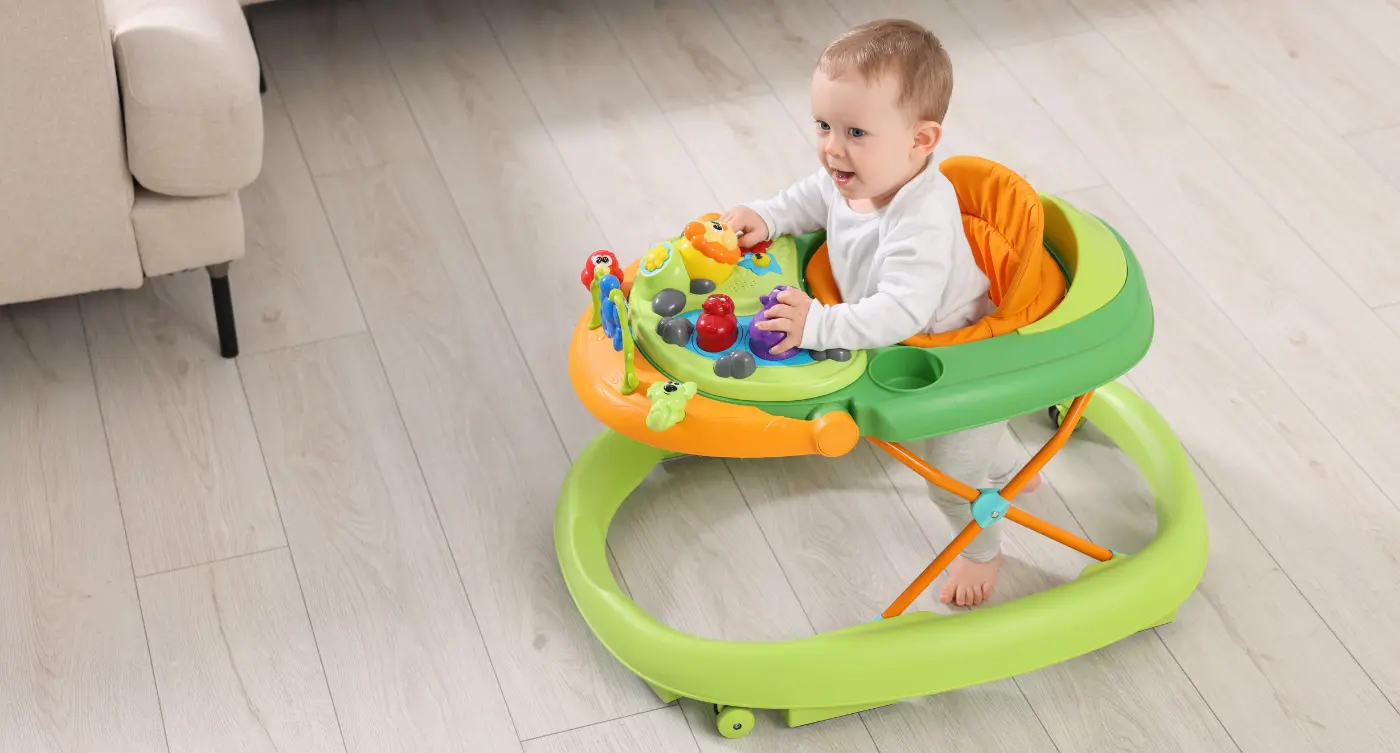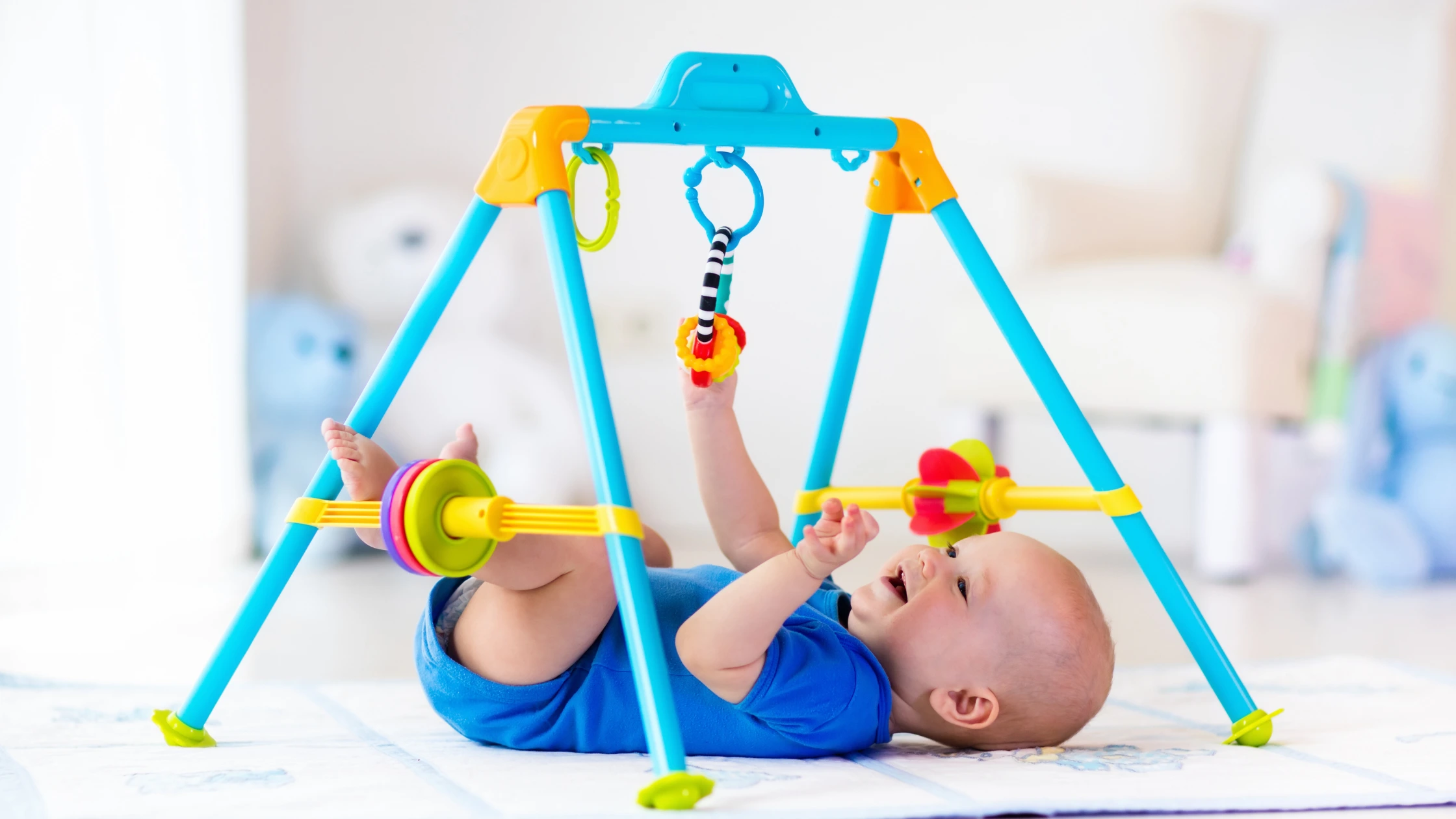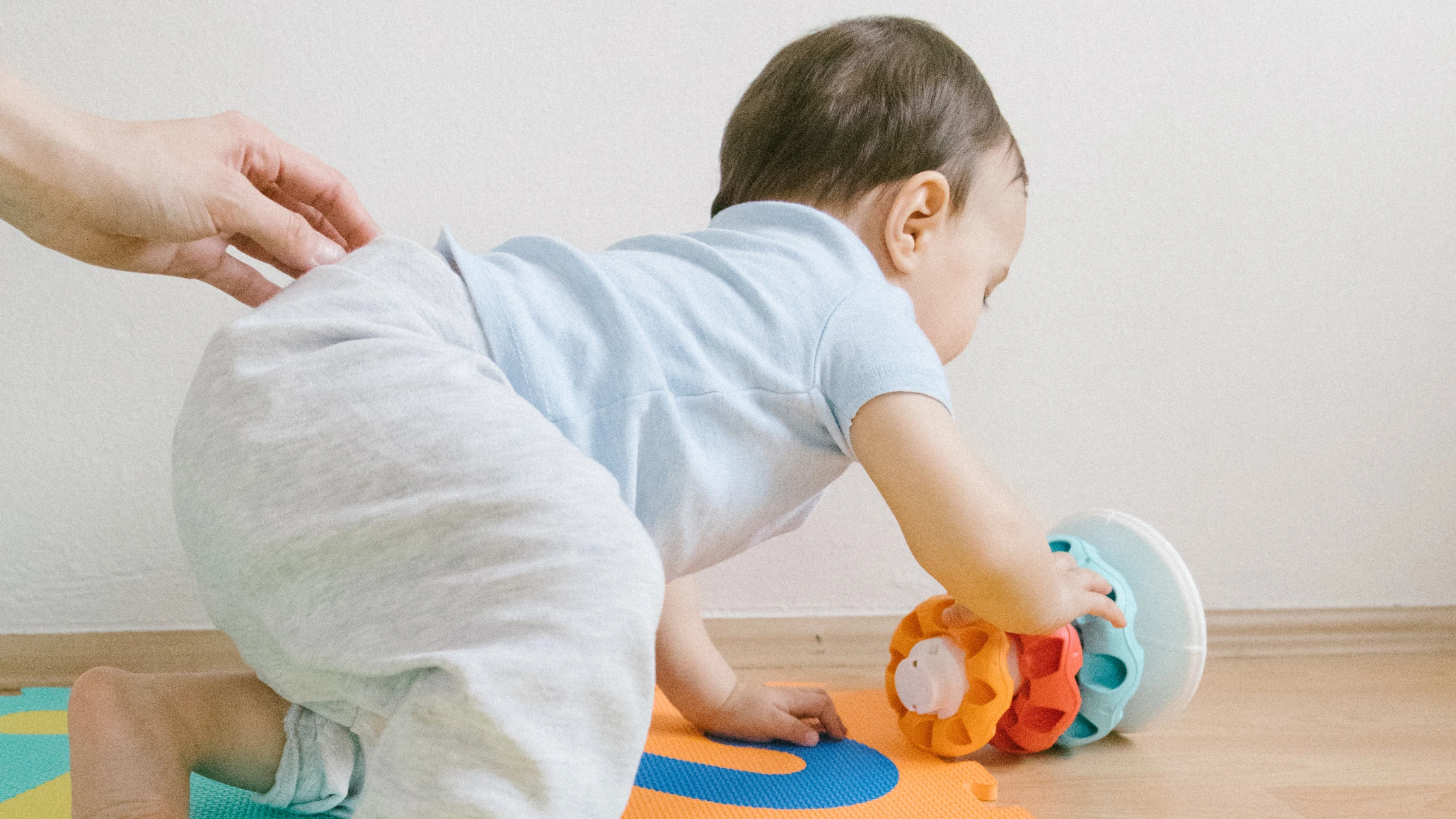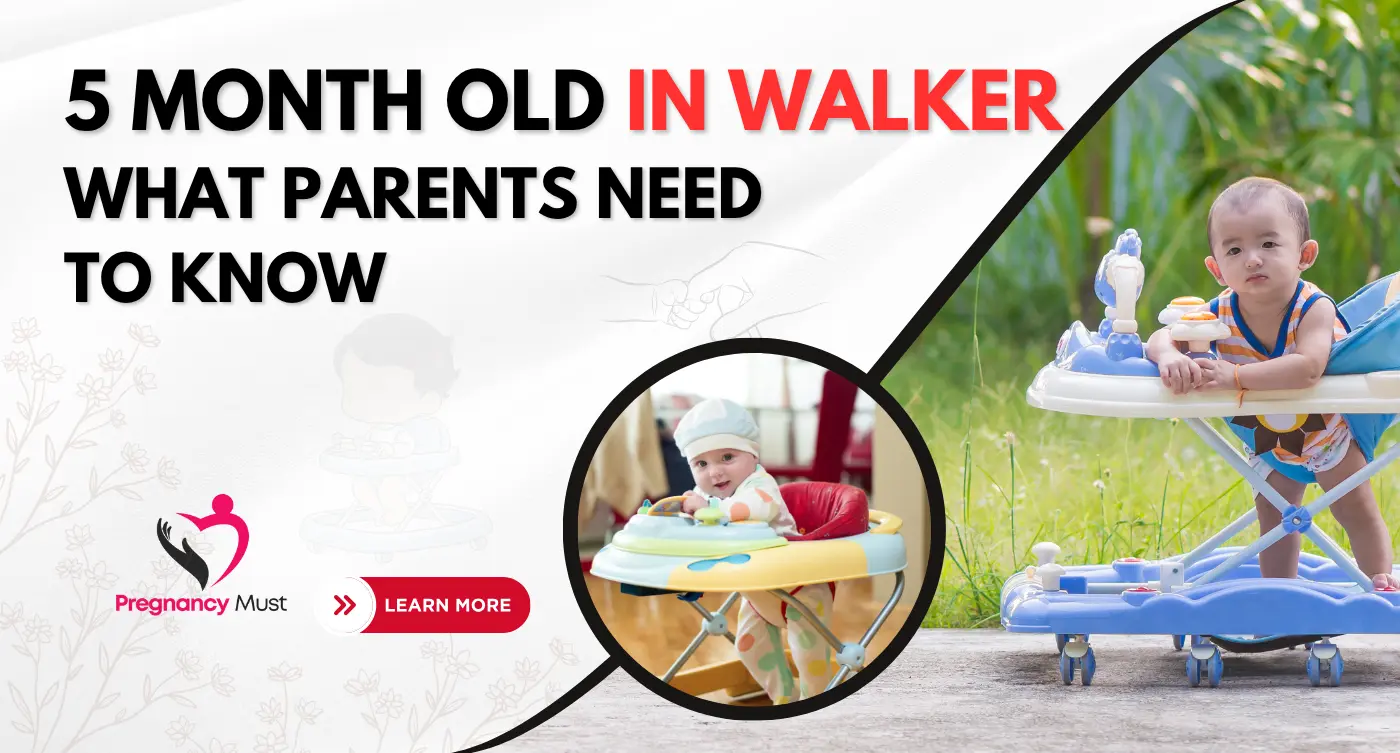Thinking about putting your 5 month old in a walker? You don’t need to face this on your own. Many parents are curious about when a baby can use a walker and what the ideal age for a baby walker might be. Walkers look beneficial, but there are important safety and developmental points to keep in mind.
You have to be aware of the fact that the muscles and coordination of the baby are not fully formed even at the age of five months. Walkers may disrupt natural developmental activities such as crawling or sitting on their own. Rather, think of floor play and tummy time under supervision, where the strength, balance, and motor skills are promoted more safely and developmentally.
Table of Contents
- Is It Safe to Put a 5 Month Old in Walker?
- Understanding Baby Development at 5 Months
- Why the AAP Discourages Early Walker Use
- Possible Risks for 5 Month Old in Walker
- Baby When Can Use a Walker Safely?
- Alternatives to Walkers for a 5 Month Old
- Encouraging Natural Mobility
- What the Research Says
- What Parents Are Saying
- Tips for Choosing Baby Gear Safely
- Pediatrician’s Advice on Walker’s Use
- Building a Safe Routine for Active Babies
- Related Questions and Answers
- Final Thoughts: Should You Use a Walker for a 5 Month Old?
Is It Safe to Put a 5 Month Old in Walker?
Walkers intended for babies make it look like a perfect solution for giving entertainment while helping your 5 month old move around. On the other hand, pediatric experts say that beginning to use a walker early in life can cause some safety issues. Understanding the age for baby walker use is crucial to avoid injuries and developmental delays.
Walkers can actually slow down the other basics, such as crawling and standing, instead of walking. Babies can also develop excessive dependency on the aid at the expense of the use of core muscles, which function to balance and coordinate. Also, there is an increase in the chances of accidents like falling down the stairs or touching harmful items by walkers. Never place a value on early mobility apparatus compared to safe and supervised play.
Understanding Baby Development at 5 Months

By five months, most babies:
- Also, control of the head and neck improves
- Learning how to flip over
- Start by sitting with help from something
- Babbling and mouthing different words
Their bodies have achieved many advances, yet they are not able to walk or move around safely quite yet.
Why the AAP Discourages Early Walker Use

The American Academy of Pediatrics (AAP) suggests not putting your baby in a baby walker until they are at least six months old. For many years, the organization has sought to stop making and selling mobile infant walkers in the U.S. because they harm children.
Walkers allow children to move quickly—up to 4 feet per second—before they can walk without help. For this reason, babies may fall, which can lead to brain injuries, and have delays in learning to walk.
Possible Risks for 5 Month Old in Walker

- Injuries from Falls
The most likely risk is falling down stairs or over objects, leading to serious head trauma, fractures, or lacerations.
- Developmental Delays
Many think, using a walker too early can hold back children from reaching important motor skills such as crawling, pulling up, and walking without help. The reason? Don’t expect your baby to be in control yet; they’re still using walkers for moving around.
- Increased Access to Hazards
Because a child in a walker enjoys moving around, they can access areas they weren’t able to before, including hot stoves, electric outlets, sharp objects, and unsafe substances.
- Poor Gait and Posture
If your baby walks early with limping or on their toes, this may result in poor posture or walking that can stay after they can walk independently.
Baby When Can Use a Walker Safely?
If you’re wondering when can a baby use a walker, the safest answer is: that most babies should avoid them entirely. Yet, if you choose:
- Be sure your baby is at least 6-8 months old before you start.
- Offer your baby time to learn how to sit independently and control their head and body movement.
- Make sure they start to support their body weight while standing or walking.
- Always be with your child while moving in a walker
- Don’t use it near any hazards or on uneven ground.
Alternatives to Walkers for a 5 Month Old
Fortunately, there are plenty of options that work well and don’t put your little one at risk.
- Stationary Activity Centers
Since these centers mimic walkers, they give your baby the chance to stand and play without the danger of falling. A lot of these carriages have rotating seats, toys, and music that are meant to help your child’s growth.
- Tummy Time
Rolling on the tummy is important for the baby’s muscles of the neck, arms, and core which are used when crawling and walking. When your baby spends time every day on his or her stomach, learning to support themselves is easier.
- Play Mats and Gyms
Using mats with toy arches can improve a child’s senses, hand-eye coordination, and movement skills. Buy play mats that have mirrors, different textures, and fabric that is crinkled.

- Baby Jumpers (Stationary Only)
After your child can sit by themselves, using a stationary jumper gives them leg exercise, without being able to move around or fall. The jumper must always sit on a flat spot for your baby’s feet to touch the ground comfortably.
- Supported Standing and Balance Activities
Help your baby while they are standing up and prompt exercises that build muscle strength. Swearing can strengthen the legs by allowing your child to play while standing at a table or holding your hands.
Encouraging Natural Mobility
Instead of relying on a walker, you can encourage natural development in the following ways:
Floor Time
Allow your baby to learn about movement by giving them space to move around safely on the floor. Put toys that your baby can’t reach near them to promote rolling, scooting, and crawling.
Assisted Sitting
Help the child to sit with support. In addition, it helps build up your back and belly muscles. Using a nursing pillow or resting your baby on your lap can help keep the whole experience safe and not stressful for you.

Toys That Encourage Reaching
Babies can learn to reach, roll, and crawl if they have soft toys or rattles nearby. Playing with others at this stage benefits your child’s body and feelings.
Create Baby-Safe Exploration Zones
There should be a place in your home where your baby can crawl or play on the floor. Put cushions and soft toys around the house, along with interactive products suitable for kids your age to encourage exploring and boost your self-confidence.
Use Mirror Play
Mirrors made for babies are good additions during playtime or when your baby is on their tummy. Looking at faces, including their own, makes babies very happy. Moving a toy in front of the mirror may make children want to reach, move, and look around.
Encourage Parent-Baby Interaction
Peekaboo and rolling games develop trust, improve dexterity, and improve focus in your child. This kind of play helps kids develop naturally better than walkers do.
Choosing such activities is good for your baby’s well-being and mental development.
What the Research Says
Experts have often warned that using walkers early in life can be harmful. Pediatrics in 2018 reported in a publication that:
- 230,676 children under the age of 15 months visited ERs due to walker injuries in the range of the years 1990-2003
- Falling down stairs accounted for over 75% of these injuries.
Many experts agree that walkers can be hazardous more often than helpful, mainly when given to small children early on.
What Parents Are Saying
Real Experiences
“ We felt our baby walk faster if we gave them a walker. He enjoyed it at the beginning, but after some time, we could tell he always preferred walking on the ball of his foot. It took months to correct his posture.” – Emma, mother of a 1-year-old
“ My decision at five months was to start with a play mat and activity gym rather than a walker. By 6.5 months my baby crawled and by 11 months, she was walking!” – Tara, first-time mom
Tips for Choosing Baby Gear Safely
If you’re selecting walkers or activity gear, make sure they match these standards:
- Certified by ASTM or JPMA safety standards
- Having a wide base to be steady
- Includes built-in brakes or resistance features
- Never used near stairs, kitchens, or bathrooms
Pediatrician’s Advice on Walker’s Use
It’s usually smart to get your doctor’s advice before placing your child in a walker. They are able to look at where your baby is in their development and offer personal advice. Today, many specialists in child health recommend not using walkers and suggest that they encourage motor skill development instead.
Building a Safe Routine for Active Babies

A baby who cannot wait to move is a sign that they are growing in good health. Keep encouraging this by:
- Make tummy time a regular part of your child’s day
- Setting up an area for your child to explore and play safely
- Making sure children have toys that encourage them to learn and move
If you help your baby learn these safe behaviors, they will move from crawling to pulling up, cruising, and finally walking.
Related Questions and Answers
Is 5 Months Too Early for a Walker?
Yes. Pediatricians advise against walker use for most 5-month-olds because they are not strong enough. To avoid problems later, it’s a good idea to choose safer ways to play.
What Is the Right Age for Baby Walker Use?
There is no universally “right” age for baby walker use, as many pediatricians recommend avoiding them altogether. The walker should only be introduced once your baby can sit unaided and support their own weight which usually happens after 6 months.
Can a Walker Help My Baby Walk Sooner?
No. Surprisingly, many babies are late to start walking. A baby’s physical growth and balance improve naturally when they play on the floor and move.
Final Thoughts: Should You Use a Walker for a 5 Month Old?
Most experts say walkers should not be given to infants until they are older. 5 month baby in a walker can hamper the natural growth more than help. In fact, let your child learn with time naturally, encourage floor play, and include interactive toys in their activities.
When using a mobility aid, delay its use until your baby is around 6-8 months, can stand and walk, and you are available to prevent accidents.
Explore more on Pregnancy Must–
